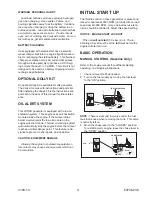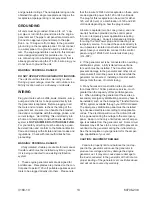
3180-10
12
60706-238
OPERATING SPEED
The engine-generator must be run at the correct
speed in order to produce the proper electrical volt-
age and frequency.
CAUTION: EQUIPMENT DAMAGE
The output voltage should be checked to ensure
the generator is working properly prior to connecting
a load to the generator. Failure to do so could result
in damage to equipment plugged into the unit and
possible injury to the individual.
All engines have a tendency to slow down when a
load is applied. When the electrical load is con-
nected to the generator, the engine is more heavily
loaded, and as a result the speed drops slightly.
This slight decrease in speed, together with the
voltage drop within the generator itself, results in a
slightly lower voltage when the generator is loaded
to its full capacity than when running no load. The
slight variation in speed also affects the frequency of
the output current. This frequency variation has no
appreciable effect in the operation of motors, lights
and most appliances. However, electronic equip-
ment and clocks will be affected if correct RPM is
not maintained. See Load vs. Output chart.
Although individual units and models vary slightly,
the normal voltage and frequency of the engine-gen-
erator described in this manual are approximately as
follows, under varying loads:
LOAD VS. OUTPUT
Generator
Load
Speed
(RPM)
Frequency
(Hz)
Voltage
None
3690
61.5
125V
Half
3600
60.0
120V
Full
3510
58.5
115V
The speed of the engine was carefully adjusted at
the factory so that the generator produces the prop-
er voltage and frequency. For normal usage, the
speed setting should not be changed. If the genera-
tor is being run continuously on a very light load, it is
often advisable to lower the operating speed slightly.
CAUTION: EQUIPMENT DAMAGE
SPEED ADJUSTMENTS SHOULD ONLY BE
MADE BY A QUALIFIED SERVICE TECH.
Whenever making any speed adjustments,
check the unit with a voltmeter and a frequency
meter or tachometer and be sure the voltage and
speed are correct.
Lower voltage may damage both the generator and
any load connected to it. Running the engine at ex-
cessively high speeds results in high voltage, which
may signifi cantly shorten the life of appliances being
used.
Output voltage should be checked periodically to
ensure continued proper operation of the generat-
ing plant and appliances. If the generator is not
equipped with a voltmeter, it can be checked with a
portable meter.
CONNECTING THE LOADS
Allow the engine to warm up for two or three minutes
before applying any load. This will allow the engine
to reach normal operating temperature and oil to cir-
culate throughout the engine. A short warm-up time
will permit the engine to work more effi ciently when
the load is applied and will reduce the wear in the
engine, extending its life.
Receptacles have been provided to allow loads to
be connected to the generator. The loads should
be added one at a time. If a large motor is being
started; or multiple motors are being started, they
should be started individually and the largest should
be started fi rst.
CAUTION: EQUIPMENT OVERLOAD
Keep the generator load within the generator and
receptacle nameplate rating. Overloading may cause
damage to the generator and/or the loads .
Most electric tools and appliances will have the volt-
age and amperage requirements on their individual
nameplates. When in doubt, consult the manufac-
turer or a local electrician. The nameplate amperage
rating for electric motors can be misleading. See
“Starting Electric Motors” in Unit Capabilities (page
4).
These engine-generator sets are inherently self regu-
lating based on engine speed. The engine governor
will automatically adjust itself to the load. No harm
to the generator will result if it is operated with no
load connected. Proper utilization of the receptacles
located on the control panel is necessary to prevent
damage to either the receptacles or the generator.
The generator is a limited source of electrical power,
therefore, pay special attention to the receptacle






































